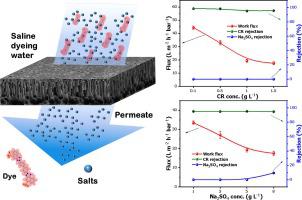当前位置:
X-MOL 学术
›
Chem. Eng. J.
›
论文详情
Our official English website, www.x-mol.net, welcomes your feedback! (Note: you will need to create a separate account there.)
A loose polyethersulfone hybrid nanofiltration membrane incorporated with polyethyleneimine-decorated silica nanoparticles for highly-efficient dye/salt separation
Chemical Engineering Journal ( IF 15.1 ) Pub Date : 2024-03-26 , DOI: 10.1016/j.cej.2024.150643 Ziyang Zhang , Yongchang Song , Lihua Xie , Qiang Liu , Jingye Li , Bowu Zhang
Chemical Engineering Journal ( IF 15.1 ) Pub Date : 2024-03-26 , DOI: 10.1016/j.cej.2024.150643 Ziyang Zhang , Yongchang Song , Lihua Xie , Qiang Liu , Jingye Li , Bowu Zhang

|
Loose nanofiltration (LNF) is a newly-developing technology for desalting dye-containing saline effluents, but suffers from membrane materials with low permeance and poor dye/salt separation selectivity. Herein, a hybrid polyethersulfone (PES) LNF membrane for dye/salt separation was prepared via a nonsolvent-induced phase inversion method, which was carried out using polyethyleneimine (PEI)-modified silica nanoparticles as a dopant. This design not only featured a hybrid PES LNF membrane with high porosity and small mean pore size, but also partially neutralized its charge and enhanced its hydrophilicity. Hybrid PES LNF membrane from a 21-wt% PES solution with 3-wt% PEI-decorated silica nanoparticles addition was demonstrated to achieve high water permeance (92.0 L m h bar) and dyes retention ratio (98.4 % for Congo Red, 98.8 % for Nile Blue A, and 95.1 % for Methyl Blue) accompanied with fully-pass for various salts (NaSO, NaCl, MgCl and CaCl). In addition, the hybrid membrane exerted excellent resistances to strong acidic, oxidative and hot water (90 °C) environments and exhibited a pH-sensitive permeability. Multicycle test revealed that the hybrid membrane had high permeance recovery ratio (>92.8 %) and maintained its high dye retention and complete salt permeation even after 10 cycles, manifesting its outstanding fouling resistance and recyclability. Besides, the hybrid membrane repelled 92.6 % of dyes from a simulated wastewater consisting of multiple industry-applied direct dyes and salts after 12 h consecutive test, but allow 100 % of mixed salts passing through the membrane, proving its practical applicability to industrial dyeing wastewater. This study provided a simple and economically feasible route to high-performance LNF membrane production for dye/salt separation, thus popularizing LNF process in dyeing wastewater treatment, organic products purification, and resource recovery.
中文翻译:

松散的聚醚砜杂化纳滤膜与聚乙烯亚胺修饰的二氧化硅纳米粒子结合,可实现高效的染料/盐分离
松散纳滤(LNF)是一种新兴的含染料盐水脱盐技术,但其膜材料渗透率低,染料/盐分离选择性差。在此,通过非溶剂诱导的相转化方法制备了用于染料/盐分离的杂化聚醚砜(PES)LNF膜,该方法使用聚乙烯亚胺(PEI)改性的二氧化硅纳米颗粒作为掺杂剂。该设计不仅具有高孔隙率和小平均孔径的混合PES LNF膜,而且还部分中和了其电荷并增强了其亲水性。由 21 wt% PES 溶液和添加 3 wt% PEI 修饰的二氧化硅纳米粒子制成的混合 PES LNF 膜经证明可实现高透水性(92.0 L mh bar)和染料保留率(刚果红为 98.4%,刚果红为 98.8%)。尼罗蓝 A 和甲基蓝 95.1%),各种盐(NaSO、NaCl、MgCl 和 CaCl)均完全通过。此外,杂化膜对强酸性、氧化性和热水(90℃)环境具有优异的耐受性,并表现出pH敏感的渗透性。多次循环测试表明,杂化膜具有较高的渗透恢复率(>92.8%),即使在10次循环后仍保持较高的染料保留率和完全的盐渗透性,表现出其优异的抗污染性和可回收性。此外,连续12小时测试后,该杂化膜对由多种工业应用的直接染料和盐组成的模拟废水中的染料进行了92.6%的排斥,但允许100%的混合盐通过膜,证明了其对工业印染废水的实际适用性。该研究为生产用于染料/盐分离的高性能LNF膜提供了一种简单且经济可行的路线,从而在印染废水处理、有机产品净化和资源回收方面推广LNF工艺。
更新日期:2024-03-26
中文翻译:

松散的聚醚砜杂化纳滤膜与聚乙烯亚胺修饰的二氧化硅纳米粒子结合,可实现高效的染料/盐分离
松散纳滤(LNF)是一种新兴的含染料盐水脱盐技术,但其膜材料渗透率低,染料/盐分离选择性差。在此,通过非溶剂诱导的相转化方法制备了用于染料/盐分离的杂化聚醚砜(PES)LNF膜,该方法使用聚乙烯亚胺(PEI)改性的二氧化硅纳米颗粒作为掺杂剂。该设计不仅具有高孔隙率和小平均孔径的混合PES LNF膜,而且还部分中和了其电荷并增强了其亲水性。由 21 wt% PES 溶液和添加 3 wt% PEI 修饰的二氧化硅纳米粒子制成的混合 PES LNF 膜经证明可实现高透水性(92.0 L mh bar)和染料保留率(刚果红为 98.4%,刚果红为 98.8%)。尼罗蓝 A 和甲基蓝 95.1%),各种盐(NaSO、NaCl、MgCl 和 CaCl)均完全通过。此外,杂化膜对强酸性、氧化性和热水(90℃)环境具有优异的耐受性,并表现出pH敏感的渗透性。多次循环测试表明,杂化膜具有较高的渗透恢复率(>92.8%),即使在10次循环后仍保持较高的染料保留率和完全的盐渗透性,表现出其优异的抗污染性和可回收性。此外,连续12小时测试后,该杂化膜对由多种工业应用的直接染料和盐组成的模拟废水中的染料进行了92.6%的排斥,但允许100%的混合盐通过膜,证明了其对工业印染废水的实际适用性。该研究为生产用于染料/盐分离的高性能LNF膜提供了一种简单且经济可行的路线,从而在印染废水处理、有机产品净化和资源回收方面推广LNF工艺。



























 京公网安备 11010802027423号
京公网安备 11010802027423号